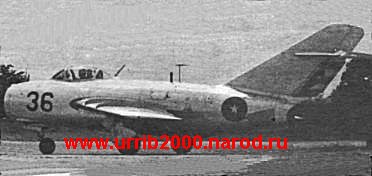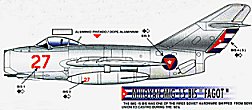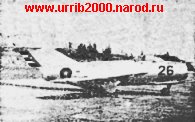

The MiG-15 Fagot in CubaRuben Urribarres |
 This
famous fighter of the Korea War, begins to be projected in 1946 with aid of the
aeronautic studies captured in Germany and with the engine bought in Great Britain
Rolls-Royce Nene-I of 2,270 kg of pushing.
This
famous fighter of the Korea War, begins to be projected in 1946 with aid of the
aeronautic studies captured in Germany and with the engine bought in Great Britain
Rolls-Royce Nene-I of 2,270 kg of pushing.
Its first flight was in December 30, 1947 with the original British engine, that then
is manufactured as "Klimov RD-45". The first MiG-15 manufactured in series
appears in December of 1948 and the first Regiments of MiG-15 are ready for 1949.
At September 1949 does their first flight the modification MiG-15bis, with
a motor RD-45F, copy of the Rolls-Royce Nene-II, of 2,700 kg of pushing.
Its production begins in 1950.

The USSR manufactures 13,131 MiG-15 fighters of various types in 8 factories from 1949 to 1959. Also they produce it for license Poland (1,000 monoplazas Lim-1/Lim-2 manufactured) and Czechoslovakia (1,473 monoplazas Aero S102/S103 and 2,012 biplazas CS102), Chinese (Shenyang JJ-2/FT-2 biplazas). In all the total of MiG-15 produced reach more than 17,616 airplanes. It served in the Air Force of 37 countries, and fights in numerous conflicts as Korea (1950-1953), Hungary (1956), Medium East (1956, 1967), Yemen (1962-1967), collisions Chinese-Taiwan, and others.
![]() Arrival to Cuba: to late for Bay of Pigs
Arrival to Cuba: to late for Bay of Pigs
Months
after the triumph of the revolution of Castro, in the same one 1959 year begin
the Soviet-Cubans contacts for the shipment of weapons to the island. March
4, 1960 exploits in terrorist crime in the port from Havana the Belgian ship "The
Coubre", loaded of rifles FN FAL and others arm for the Cuban Army, with a balance
of 100 dead persons. Two days later Fidel and Raúl Castro invite
to Alexandr Alexeiev, who was the extraoficial representative of the USSR
in Cuba (not yet there were diplomatic relations), to a long chat. Fidel
explains to Alexeiev, that "The Coubre" was sabotaged for the Americans, and that
to avoid such acts in the future, will do since now them asked of weapons directly
to the oriental block. By first time is made a direct asked of MiG-15 fighters.
But the USSR hesitates, and only with the visit of Raúl Castro to Moscow
in June of 1960, Nikita Jrushov accepts the delivery of weapons in large quantities,
including the MiG-15.
 |
|
In spite of erroneous western reports, did not have still MiGs in Cuba neither pilot of such fighters during the Bay of Pigs battles of April of 1961. In reality the first MiG-15 arrive at Cuba at the end of May of 1961, a month after Bay of Pigs. They were 20 MiG-15bis and 4 MiG-15UTI. In Cuba were not primary versions MiG-15. With these equipment are formed the first two MiG-15bis Squadrons. The aircrafts for a third MiG-15bis Squadron arrives at end of 1961. In 1961 in total arrive 41 MiG-15bis, MiG-15Rbis, MiG-15UTI and MiG-19P.
For their assembled and the pilot training in Cuba, at the beginning of June of 1961 arrive more than one hundred of advisors from the USSR, by the command of the Colonel Guenady Shadrin (Soviet Union Hero, and WWII Ace with 14 victories of German aircrafts). These specialists begin to assembling the MiG-15bis on June 6, 1961 San Antonio Air Base. To catch experience, in this job participated also the Cubans technician, that still worked in the old Sea Fury, T-33 and B-26.
![]() First Flights
First Flights
The first Cubans that
flying the MiG-15 were Alvaro
Prendes and Douglas Rudd, when in November de1960 they visit Czechoslovakia
in secret mission of weapons purchase. When arriving the MiG-15 to Cuba, they
form a group of 6 pilots chosen to be trainned in the new fighters. The other
four pilots were the also Bay of Pigs veterans Enrique
Carreras, Rafael del
Pino, Gustavo Bourzac and Alberto Fernández. Already in Cuba the first
pilot that flying the MiG-15 was Enrique
Carreras, on June 24, 1961 (2 months and half after Bay of Pigs). These 6
pilots begin urgently the theoretical course in July of 1961, and the practical
in August, the course of instructors in September, intensively transmitting the
knowledge to the others Cubans young pilot, that were trainned in Cuba since 1959
in the Batista´s technique.
| |
 |
The first Squadron is called "Carlos Ulloa", in honor of the Sea Fury nicaraguan pilot that dead in Bay of Pigs. The Leader of the MiG-15bis Squadron is appointed Enrique Carreras, as Second Leader the Captain Álvaro Prendes, the Leaders of Escuadrillas were the captains Alberto Fernández, Rafael del Pino and Douglas Rudd. To the end of 1961 already are ready two MiG-15bis Squadrons. In total the Russians form in Cuba in june-december of 1961 almost 50 pilots of MiG-15bis and MiG-19P. In July of 1961, a month after to be received the MiG-15bis, four of them participate in its first operation in cooperation with the grounds troops. That were exercises of air support to a Tank Battalion of T-34-85 in their offensive, in the fire poligon of Matanzas. The Leader of the Escuadrilla was Enrique Carreras, accompanied by Alvaro Prendes, Rafael del Pino and Douglas Rood. The MiG-15bis taken off from Varadero to attack the objective that simulated landing enemy forces. In November of 1961 with the following aircrafts was formed an recognition Squadron based in the aerodrome of Ciudad Libertad (old Columbia), formed by 10 MiG-15bis, MiG-15Rbis and 2 MiG-15UTI. Showing its preparation, 11 MiG-15bis fly in the parade air of January 2, 1962.
Since 1960 also were being prepared Cubans MiG-15 pilots in Czechoslovakia,
USSR and Chinese. On October 11 the American SIGINT grasps the first radio
chat of MiG-15 pilots in Spanish from the air base of Trencin, Czechoslovakia.
The first 21 pilot graduates in Czechoslovakia arrive in March of 1962 for flying
in the 3rd MiG-15bis Squadron, in this same year arrive others 74 MiG-15 pilots
trainning in China. Great part of the candidates to MiGs pilots that were sent
to USSR and Czechoslovakia in 1960, were son of the Socialist Party (Communist)
leaders, that planned controlling the aviation at the new government. Among them
the son of the legendary communist Leaders Jesús Menéndez (1911-1948)
and Blas Roca (1908-1982) Carlos Jesús Menéndez and Vladimiro Roca.
 |
 |
 |
 |
| | |
|
|
![]() Cuban Missile Crisis
Cuban Missile Crisis
The tension
around Cuba grows. On March 13, 1962 the Joint Chiefs of Staff send to the
consideration of the U.S. Secretary of Defense a document with measured that could
justify an American intervention in Cuba. Among them it was to disguise an USAF
F-86 Sabre fighter as an FAR´s MiG-15, to attack Americans objective, and
wrote: "Use of MIG-type aircraft by US pilots could provide additional provocation.
Harassment of civil air, attacks on surface shipping, and destruction of US military
drone aircraft by MIG type planes would be useful. An F-86 properly painted would
convince air passengers that they saw a Cuban MIG, especially if the pilot of
the transport were to announce that fact"
By the Cuban Missile Crisis
in October of 1962, there were 36 MiG-15bis and MiG-15Rbis in Cuba, in three Squadrons
(besides the MiG-15UTI). Avoiding to be destroyed in ground, these airplanes were
dispersed between several bases: San Antonio, Santa Clara, Camagüey, Holguín.
The MiG-15bis take off frequently trying to intercept the Americans RF-101 and
RF-8 over Cuba. But by the lack of radars in the FAR, impeded that the MiGs take
off with the necessary time for an efficient intercepción (the radares
were in the hands of the Soviet troops). The MiG-15Rbis did flights of reconnaissance
by an possible American disembark. The future Cuban Cosmonaut Arnaldo
Tamayo (today General) did 20 interception and reconnaissance flights
in the MiG-15bis and MiG-15Rbis from San Antonio, in the days of the Crisis.
In the sixties were frequent the incursions of speed gunned botes from the Florida to Cuba, organizated by the CIA or the Cuban exiled. The CIA used "mothers ships" from where were sent the speed gunned botes for attacks or infiltrations of secret agents in the Cuban coasts. One of the more actives ships was the Rex, a 52 meters large anti submarine ship of the WWII. The ship was armed with a 57mm gun, a 40mm twin tube gun and 8 machine guns of 12,7mm. Against the Rex was prepared an ambush. In the operation would participate four Il-14R of reconnaissance with light bombs and two 250kg bombs, and four MiG-15bis.
On October 21, 1963 the Rex
approached at midnight to the San Antonio Cape, in the Pinar del Río
province, to disembark two speeds boats with a team of 12 commands, in only one
km from the coast. When the commands approaching to the edge, they not received
the agreed signal from their men in ground . They understood that fell in an ambush,
and opened fire. Form the edge responded and was destroyed one of the boats. The
second boat fleed to the Rex, pursued by Cuban launches that appeared in the night.
But the Rex return in full speed. The Rex´s Captain Brooks orders to leave
to open sea, but then he returns to the coast, navigating fence the coast to not
be detected by the radars, in maneuver of deceit. Few minutes later, in the same
point where had been the Rex, appeared two Mi-4 helicopters, throwing light bombs.
The assistant of the Captain of the Rex counts: "So only we had passed the
Cape, when I saw the lights of a merchand ship. I wright now understood what was
going to happenned. The merchant entered to the illuminated zone, and the Cubans
thought that these were our ship. And they opened fire". 
The merchant was the "G.Louis" of 32,500 tons, registered in Liberia,
that now carried minerals from Jamaica to Texas. Was 00.40 of the night, when
arrived the Il-14R, that illuminated the zone. In the meantime appeared
the 5 MiG-15bis that attacked the ship with rockets and fire gun, doing various
pass. The ship was already on fire, (although the fire was dull three hours after),
and its Captain asked SOS by radio: "Castro´s MiGs Fighters attack us
near the Cuban coasts!!". To the alarm respond and from Key West (350
km to the north) taked off the US NAVY F-4 Phantom II to the zone. But
when the Phantom already were near Cuba, they receive the order of returning.
The CIA monitored the communications of the incident, the Rex did not give signs,
and they understood that the Cuban MiG-15bis were attacking an wrong objective.
While the MiG-15 were occupied with the "G.Louis", the Phantom don´t
must appear, and the Rex would be able to flee.
The Rex escaped toward
Yucatán, Mexico, and when the Cubans understood this, the MiG-15bis attacked
it, damaging. But already the Rex was far away, the MiG-15 were lack of fuel and
munition, and return. Then two Cuban coast guard, that pursued it until Cozumel,
but not enter in the Mexican waters. After two days of wait to the Rex, they retired.
Although the Rex could flee, since that night this type of activities of the CIA
against Cuba diminished drastically. According to Russian sources, that night
some of the MiG-15bis were piloted by Russian advisors. The USSR Government wanted
to punish them for the mistaken of ship, but the Government of Castro assumed
the responsibility, and they were forgiven. The U.S. Government tried to present
a protest by the attack of the ship "G.Louis". But Castro advanced presenting
on October 30 to the Cuban TV four prisoners from the "Rex", commenting for hours
the incident, and informing about the exact location of the Rex ship in Key West.
Begin the corresponding scandal in the American press. That finishes the most
famous incident with the Cubans MiG-15.
 |
|
 |
![]() Other actions
Other actions
In 1963 the MiG-15bis
take part in a exercise toward the Havana coast, where they sink a ship that the
MiG-21F-13 had failed. In the same year of 1963 two
F-8 Crusader of an VMF Squadron intercepted a pair of FAR´s MiG-15,
that bother the reconnaissance mission of a Lockheed P-3 Orion, around
the Cuban water. The F-8 pilots asked permission to confront the MiGs, but the
permission arrived only when each side already go home. One of the Marine pilot,
a Major, when arriving to the Key West Air Base, remover furious the helmet and
kicked it.
In 1964 arrive the MiG-17, and then the MiG-15bis of Santa Clara pass to Holguín. More MiG-15UTI were acquired after the Missile Crisis until arrive several dozens of these trainers. A MiG-15UTI was sent to Angola in 1975 as part of the squadron of MiG-17. The MiG-15UTI had a long career, trainning the following generations of pilots, until the arrival of the Aero L-39C Albatros in 1981.
![]() MiG-15 versions in Cuba
MiG-15 versions in Cuba
In Cuba were received three variants of the MiG-15 fighter

![]() MiG-15bis
Fagot B -Modernized MiG-15 version, with Klimov VK-1 engine of 2,700 kg thrust
(A more powerful engine RD-45F), reinforced wings, two aditionals fuel wing tanks,
of 600 liters, bigger air brakes.
MiG-15bis
Fagot B -Modernized MiG-15 version, with Klimov VK-1 engine of 2,700 kg thrust
(A more powerful engine RD-45F), reinforced wings, two aditionals fuel wing tanks,
of 600 liters, bigger air brakes.

![]() MiG-15UTI Midget
-Two seat version for trainning. First flight in 1949. The same basic MiG-15,
but with engine Klimov RD-45F of 2270 kg thrust (Rolls-Royce Nene-II), and armed
only with a 12,7mm machine gun UBK-E, and 200 kg of bombs. In Cuba in 1962 and
served until the 80´s.
MiG-15UTI Midget
-Two seat version for trainning. First flight in 1949. The same basic MiG-15,
but with engine Klimov RD-45F of 2270 kg thrust (Rolls-Royce Nene-II), and armed
only with a 12,7mm machine gun UBK-E, and 200 kg of bombs. In Cuba in 1962 and
served until the 80´s.

![]() MiG-15Rbis (SR)
Fagot -Reconnaissance version of the MiG-15bis, with a photo camera AFA-40
in the place of the 37mm gun, is the only external difference. Armed with only
a 23 mm gun. Built 354 aircrafts from 1951.
MiG-15Rbis (SR)
Fagot -Reconnaissance version of the MiG-15bis, with a photo camera AFA-40
in the place of the 37mm gun, is the only external difference. Armed with only
a 23 mm gun. Built 354 aircrafts from 1951.
![]() Characteristics. MiG-15bis Fagot (MiG-15UTI Midget):
Characteristics. MiG-15bis Fagot (MiG-15UTI Midget):
| Year: 1948 (1949)
Lenght, m.: 10,86 (10,10) Wingspan, m.: 10,08 (10,08) Height, m.: 3,70 (3,70) Wing area, m.: 20,60 (20,60) Weights Empty weight, kg.: 3,681 (3,500) Normal take off weight, kg.: 5,044 (4,850) Maximum take off weight, kg.: 6,100 Fuel, kg.: 1,173 (1,200) Adicional fuel, litres: 600 (600) Performances Máximum Speed, km/h.: 1,076 (1,015) Maximum Speed at sea level, km/h.: 1,076 |
Ceiling, m.: 15,500 (14,825)
Range, km.: 1,330 (950) Maximum Range with aditional fuel, km.2,520 Climb,m/s: 50 G: 8 Engine.: Klimov VK-1 (RD-45F) Dry thrust, kg.: 2,700 (2,270) Armament Gun: 1 N-37D x 37 mm with 40 rounds and 2 NS-23 x 23 mm with 160 rounds each (a machine gun UBK-E x 12,7 mm with 120 round) Combat Loadtwo bombs of 50 or 100 kg until a total of 200 kg |
![]() Photos
Photos
| | MiG-15bis during exercises over the Havana coast Havana, in 1966 |
 | Three "Cuban" MiG-15 when was filmed TV show with PCAM´s F-14. Restored in Aerocrafters Inc. with the serials 205, 203, 308. Photo from the PCAM's Home Page |
 | Photo of a FAR´s MiG-15bis from the "MiG-15 in Action", by Hans-Heiri Stapfer. This edition afirm that in Cuba during the Bay of Pigs combats were some MiG-15, and ten pilots for them, that is not correct. In reality the first MiG-15 arrive a month and half later, and the pilots later. Courtesy of Mike Little |
| | FAR´s MiG-15UTI Midget, from "MiG-15 in Action". The commentary afirm erroneous that they were painted in camouflage only later. See photo below. Courtesy of Mike Little |
 | San Antonio Air Base, April 15 of 1963, ceremony of the DAAFAR´s Day. The closest fighters are two MiG-15bis (one of them is the same seried 36 from above), and one MiG-19. Already by this early time were MiG-15 painted in camouflage. Courtesy of the Soviet pilot Mijail Isaev |
|
|
|
|
|||




